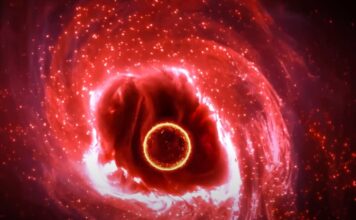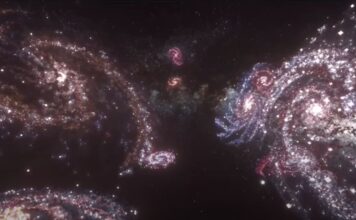Exploding flashes of light in the universe from time to time is nothing new, but when a light comes from 8.5 billion light-years away and is as luminous as a trillion suns combined, we don’t quite understand what’s going on.
According to new research, the light, dubbed AT 2022cmc, actually comes from a jet of material spilled from a supermassive black hole, propelling at supersonic speeds and pointing directly at Earth.
AT 2022cmc was discovered by the Zwicky Transient Facility (ZTF) in February this year, and it is about 8.5 billion light years away from us.
The light of more than 1 gigabit light from the light -the light of the Gigabit Gigabit Sun, imagine that the eyes are blind.
Since the discovery of AT 2022cmc, scientists around the world have been trying to decipher where and why this amazing event happened.
A total of 21 telescopes around the world collect observation data of various types of light from radio waves to high-energy gamma rays, matching all the information from neutron stars to events such as kilonovae,
According to two new papers published in Nature and Nature Astronomy by Caltech, MIT, and the University of Birmingham, the only possibility of matching AT 2022cmc is that the Swicky transient detector receives a unique tidal disruption Event (tidal disruption event, TDE), this flash comes from the supermassive black hole jet, and the direction of the jet is directed at the earth.
According to the MIT team, material from the jet travels at 99.99% the speed of light and is the most distant tidal disruption event ever detected.
There are two reasons why AT 2022cmc is so bright. First, the black hole is devouring nearby stars, releasing a lot of energy and emitting a lot of light.
Second: In general, this unusually bright burst of light may be a gamma ray burst (also a spectacular jet),
Composed of X-rays ejected from the collapse of massive stars, AT 2022cmc is 100 times more powerful than the afterglow of the most powerful gamma-ray bursts,
Analyze all the results of weeks of observations with X-ray, radio, optical, ultraviolet telescopes,
Scientists believe this may be a tidal disruption event enhanced by the “Doppler boosting” effect.
If the conclusion proves correct, AT 2022cmc will be the fourth known Doppler accelerated TDE event so far.
At present, the galaxy where AT 2022cmc is located is not visible because it is too bright. After AT 2022cmc is dimmed, the Webb telescope will have the opportunity to observe the source galaxy.




